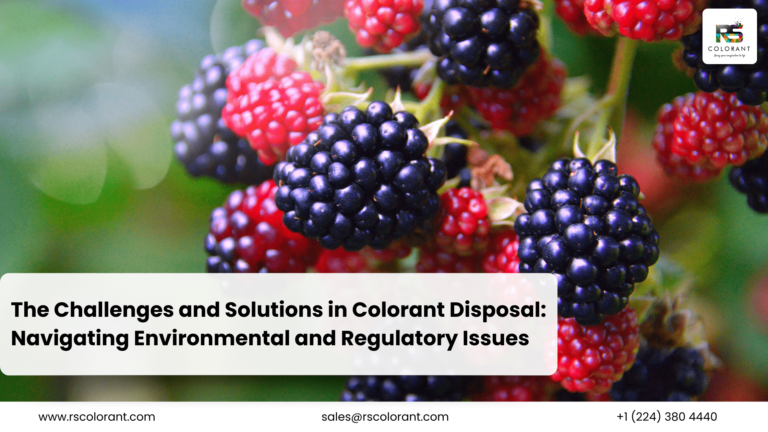Choose the right colorants – Outline
- Introduction
- Importance of choosing the right colorants
- Overview of the article’s structure
- Understanding Colorants
- Definition of colorants
- Types of colorants
- Types of Colorants
- Natural Colorants
- Sources of natural colorants
- Advantages and disadvantages
- Synthetic Colorants
- Chemical composition
- Advantages and disadvantages
- Natural Colorants
- Factors to Consider When Choosing Colorants
- Product Type
- Food and beverages
- Cosmetics
- Pharmaceuticals
- Regulatory Compliance
- FDA regulations
- EU regulations
- Consumer Preferences
- Trends in natural vs. synthetic colorants
- Cultural considerations
- Product Type
- Color Stability and Performance
- Stability under different conditions (heat, light, pH)
- Performance in various product formulations
- Safety and Toxicity
- Assessing the safety of colorants
- Toxicological studies and reports
- Environmental Impact
- Sustainability of natural colorants
- Environmental concerns with synthetic colorants
- Cost Considerations
- Cost comparison between natural and synthetic colorants
- Impact on product pricing
- Application Techniques
- Methods of incorporating colorants into products
- Best practices for uniform color distribution
- Testing and Quality Control
- Testing for color consistency
- Ensuring quality standards are met
- Case Studies
- Examples of successful colorant choices in various industries
- Lessons learned from industry leaders
- Innovations in Colorants
- Emerging trends in colorant technology
- Future prospects
- Common Mistakes to Avoid
- Pitfalls in choosing and using colorants
- How to avoid these mistakes
- Expert Tips for Selecting Colorants
- Advice from industry experts
- Practical tips for optimal colorant selection
- Conclusion
- Summary of key points
- Final thoughts
- FAQs
- How do I know if a colorant is safe?
- Can I mix different types of colorants?
- What are the most eco-friendly colorants?
- How do I ensure color consistency in my products?
- Are natural colorants always better than synthetic ones?
Introduction
Choosing the right colorants for your products is crucial. The color of a product can significantly impact consumer perception, brand identity, and overall market success. In this comprehensive guide, we’ll explore everything you need to know about selecting the perfect colorants for your products, ensuring you make informed decisions that align with your goals and industry standards.
Understanding Colorants
Colorants are substances used to impart color to a product. They come in various forms and can be derived from different sources. The main types of colorants include natural and synthetic colorants, each with its unique properties and applications.
Types of Colorants
Natural Colorants
Natural colorants are derived from plant, animal, or mineral sources. Common sources include fruits, vegetables, flowers, and even insects. For example, beetroot can be used to obtain a rich red color, while turmeric provides a vibrant yellow hue.
Advantages:
- Perceived as safer and healthier by consumers
- Often biodegradable and environmentally friendly
Disadvantages:
- Limited color range
- May be less stable under various conditions
Synthetic Colorants
Synthetic colorants are chemically engineered to provide a broad spectrum of colors. They are often more stable and consistent than natural colorants, making them popular in many industries.
Advantages:
- Wide range of vibrant colors
- High stability and consistency
Disadvantages:
- Potential health concerns
- Environmental impact during production and disposal
Factors to Consider When Choosing Colorants
Product Type
The type of product you’re developing greatly influences the choice of colorants.
Food and Beverages:
- Must be safe for consumption
- Regulatory compliance is essential
Cosmetics:
- Safety and skin compatibility are priorities
- Long-lasting color without fading
Pharmaceuticals:
- Must not interfere with the efficacy of the medication
- Safety and non-toxicity are crucial
Regulatory Compliance
Different regions have varying regulations regarding the use of colorants.
FDA Regulations:
- Strict guidelines on approved colorants for food, drugs, and cosmetics
EU Regulations:
- Similar to FDA but with some differences in approved substances and labeling requirements
Consumer Preferences
Understanding your target audience’s preferences can guide your colorant selection.
Trends in Natural vs. Synthetic:
- Growing demand for natural ingredients
- Consumers are becoming more health-conscious
Cultural Considerations:
- Color preferences can vary widely across different cultures
- Consider cultural significance and symbolism of colors
Color Stability and Performance
The stability and performance of colorants under various conditions are critical. Factors like heat, light, and pH can affect the color integrity.
- Heat: Some colorants degrade at high temperatures.
- Light: Exposure to light can cause fading in certain colorants.
- pH: The acidity or alkalinity of a product can alter the color.
Safety and Toxicity
Ensuring the safety of colorants is paramount. Comprehensive toxicological studies and reports can help assess the safety profile of a colorant.
- Toxicological Studies: Conducted to evaluate potential health risks
- Regulatory Reviews: Approval from regulatory bodies like the FDA or EFSA ensures safety standards are met
Environmental Impact
The environmental impact of colorants is an important consideration.
Sustainability of Natural Colorants:
- Generally more sustainable and eco-friendly
- Biodegradable and derived from renewable sources
Environmental Concerns with Synthetic Colorants:
- Can contribute to pollution during manufacturing and disposal
- Non-biodegradable and may persist in the environment
Cost Considerations
Cost is a significant factor in the choice of colorants.
- Natural Colorants: Often more expensive due to sourcing and processing
- Synthetic Colorants: Generally cheaper and more economical for large-scale production
Application Techniques
Incorporating colorants into products requires specific techniques to ensure uniform distribution and stability.
- Methods: Dissolving, mixing, or encapsulating colorants
- Best Practices: Ensuring even distribution and avoiding clumping
Testing and Quality Control
Regular testing and quality control are essential to maintain color consistency and meet industry standards.
- Testing: Ensures the colorant performs as expected in the final product
- Quality Control: Ongoing monitoring to maintain high standards
Case Studies
Learning from industry examples can provide valuable insights.
- Successful Colorant Choices: Examples from food, cosmetics, and pharmaceuticals
- Lessons Learned: How industry leaders overcame challenges
Innovations in Colorants
The colorant industry is constantly evolving with new technologies and trends.
- Emerging Trends: Use of biotechnology and sustainable practices
- Future Prospects: Innovations that promise to revolutionize the industry
Common Mistakes to Avoid
Avoiding common pitfalls can save time and resources.
- Pitfalls: Choosing the wrong type of colorant, not considering stability
- How to Avoid: Conduct thorough research and testing
Expert Tips for Selecting Colorants
Advice from industry experts can guide you in making the best choices.
- Practical Tips: Consider the end-use, regulatory compliance, and consumer preferences
- Optimal Selection: Balancing cost, performance, and safety
Conclusion
Choosing the right colorants for your products is a multifaceted decision that involves understanding the types of colorants, their applications, and the various factors influencing their selection. By considering product type, regulatory compliance, consumer preferences, and other key aspects, you can make informed choices that enhance your product’s appeal and performance.
FAQs
How do I know if a colorant is safe?
- Ensure the colorant is approved by relevant regulatory bodies like the FDA or EFSA and check toxicological reports.
Can I mix different types of colorants?
- Yes, but it requires thorough testing to ensure compatibility and stability in the final product.
What are the most eco-friendly colorants?
- Natural colorants derived from renewable sources are generally the most eco-friendly.
How do I ensure color consistency in my products?
- Regular testing and quality control measures can help maintain color consistency.
Are natural colorants always better than synthetic ones?
- Not necessarily. While natural colorants are often seen as safer, synthetic colorants can offer more stability and a wider range of colors.




